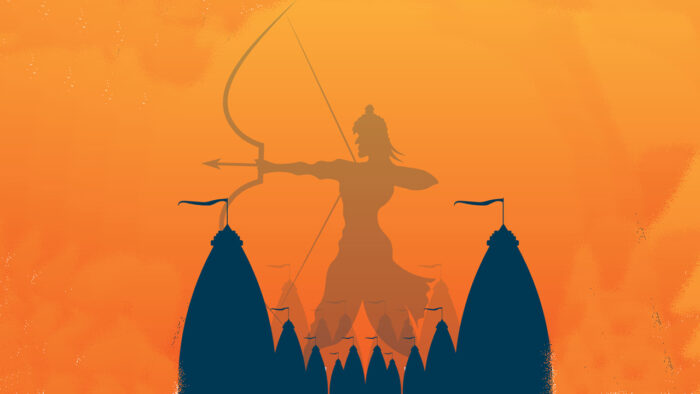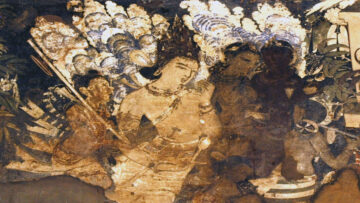The epochal ascent of Ram Lalla to his coruscating new temple in Ayodhya sent the author of this article on a veritable mnemonic fiesta of songs and stotras in praise of Sri Rama, the epitome of Universal Righteous Ruler.
A tumult of memories and feelings swirls through me as the auspicious moment of Sri Ram Lalla’s installation in his brand new mandir at Ayodhya on January 22 at half past noon approaches.
Ram Lalla! The name itself sparks a sibilant symphony. Mine comes a refrain from a lullaby heard a life-time ago:
राम लाली मेघश्याम लाली
तामरसा नयन दशरथ तनय लाली
(Rāma Lālī, Meghaśyāma Lālī
Tāmarasā nayana, Daśaratha Tanaya Lālī)
(O Playful Rama, O playful child of the blue-raincloud hue
O Rama of the red-lotus-shaped eyes, O Playful Son of Dasharatha who has red-lotus-shaped eyes.)
I hear my mother’s mellifluous voice. She is singing to put me to sleep. This may have also been her way of soft-wiring my soul. Is that the reason for that spontaneous sense of frisson I get whenever I hear Rama’s name?
At the most fundamental or primeval level, this is what “Resonant Rama” means to me personally. For I seem to have been conditioned to love the Lord almost with my mother’s milk. Also, in the tradition that I grew up in, Ram is said to be steeped in life in every atom of all its myriad aspects.
Going back to Ram Lalla’s lullaby, the word “Lali’’ also describes the quality or the fact of being unsteady, instability or unsteadiness (as of the swing or of the child’s bower or cradle). Lali also refers to a person or child who is playing or the tendency of being playful.
And to put a habitually playful child, what else does one need except a swing or a cradle; not to forget the maternal tune and a song, which, in fact, is the classic definition of a lilting lullaby.
This, in turn, reminds me of Ram Lalla’s lilting gait and the tinkling of his divine anklets. Goswamy Tulsidas celebrates this in his well-known song, “ThumakacalataRāmacaṃdra / Bājatapaiṃjaniyāṃ.” However, I got to hear Tulsidasji’s song only after I grew out of the crib in my grandfather’s house in Udupi (which stood bang next to the Udupi Krishna temple); I was then packed off to Grant Road in Mumbai to live with my father’s joint family.
Talking of joint families, when I (an Amchi or Konkani-speaking ChitrapurSaraswat) grew up and got married into a Sindhi family (from Sukkur, now in Pakistan), I discovered to my utter delight that“Hare Ram!’ was the compulsory greeting in the family.
Everybody who came to the door, be it the postman or the grocer, regardless of their dominion or belief, had to be greeted with a hearty “Hare Ram”. And that person was expected to reciprocate. This was an unbroken rule that my mother-in-law had managed to impose on her whole neighborhood and her wider circle through the sheer force of personality and affection.
My mother-in-law also invoked Sri Ram in yet another benedictory greeting: “Rakshakando Ram” (May Rama protect you). This highlights the role of Rama as the paramount warrior-guardian, both of his subjects and of righteous rule, in the Indic tradition.
This association gets reiterated indelibly in the Bhagavad Gita by Sri Krishna. In the 31st verse of the tenth chapter called Vibhuti Yoga, the Blue Lord proclaims, “Amongst purifiers, I am the wind, and amongst wielders of weapons, I am Lord Rama.“
The moot point is that lullabies promote not only somnolence but also cultural continuity and conditioning. Lullabies have proverbially been used to pass down cultural knowledge and tradition.
If the epiphany of my infancy began with Ram Lalla I also wanted our infant daughter’s rhapsody to begin with Child Rama.
To her repertoire of sleep songs, therefore, we added: “Bāḻājojo re / Kuḻabhūṣaṇānidrākariṃ māmā bāḻā, bāḻājojo re.” Here Rama gets invoked in the second phrase which adds, “Daśaratha-naṃdanabāḻājojo re.”
We also added a third phrase which invoked the name of the child’s mother, “Vimalā-naṃdinībāḻā, bāḻājojo re.” (O beloved daughter of Vimala, go to sleep; go to sleep.)
The Bāḻājojo song is tuned to Brindabani Sarang. As the name suggests, the raga is associated with Sri Krishna’s childhood years and pranks. In contrast, to my amazement, I discovered that my mother’s traditional rendition of Rama Lali was set to a rarer but absolutely apposite variant raga called Lanka-dahanSarang.
The melody Lanka-dahan, which refers to the burning of Ravana’s beautiful city by Hanuman, fuses the soothing morning raga Desi (Country) with the blazing afternoon raga Sarang. This gave me the idea of invoking (or infusing?) Heroic Hanuman for a custom-made lullaby for our daughter. Of course, this had to have Sri Ram and SitaMaiyya; and LakshmanBhaiyya as well.
As for the words, I could do no better than to borrow from Goswamy Tulsidas (here I should also mention that his Srī RāmacaṃdraKṛpāluBhajamanaharaṇabhāvabhayadāruṇam Sanskrit verses had been set to Puriya-Dhanashriraga long ago by my father’s bosom friend, the polymath-musician Pandit Chidanand Nagarkar. This song was a sort of a melodic anthem for me and my extended family).
Ultimately, for my daughter’s lullaby I chose the invocatory doha from Goswamiji’s widely recited Hanuman Chalisa:
पवन तनय संकट हरन, मंगल मूरती रूप।
राम लखन सीता सहित, हृदय बसहु सुर भूप।।
(Pavana Tanaya Saṃkaṭa Harana, Maṃgala Mūratī Rūpa
Rāma Lakhana Sītā Sahita, Hṛdaya Basahu Sura Bhūpa)
(O Son of the Wind God, Banisher of Sorrow and Embodiment of Auspiciousness, dwell in my heart, O Thou King of the Gods, Rama, together with Lakshmana and Sita.)
And I chose that most movingly melodious raga of the Hindustani musical tradition called Gara, to tune the divine words penned by the composer of that incomparable magnum opus, Ramcharitmanas.
Additionally, I used a taal or a 16-beat rhythmic cycle called Chachar to give it that pendulously-long sighing sawari (ride) of the cradle (which is pulled with a long silken cord). When the cradle is still, the lullaby is also meant to be coupled with a gently soothing repetitive touch provided by the parent’s palm on the baby’s back (which, modern science now tells us, instantly produces a relaxing rush of feel-good `cuddle chemicals’ such as Oxytocin)!
As she started talking, Ambika, our “A for Amazing” Kido, began to wow us with her seemingly instant poetic ability and perfect pitch musicality. To her doting grandparents, this was the result of a blessing bestowed upon the child due to her parents’ singular devotion to Sri Ajaneyaswami aka Hanuman.
Indeed, according to my mother, it is not for nothing that Hanumanji is worshipped as the Chieftain of the Cognoscenti (BuddhimattamVarishtam); not only does He possess unlimited strength (Atulita–Bala-Dhamam) but He is also a paragon of musicality. And so it is.
Feature Image Credit: istockphoto.com
Disclaimer: The opinions expressed in this article belong to the author. Indic Today is neither responsible nor liable for the accuracy, completeness, suitability, or validity of any information in the article.








